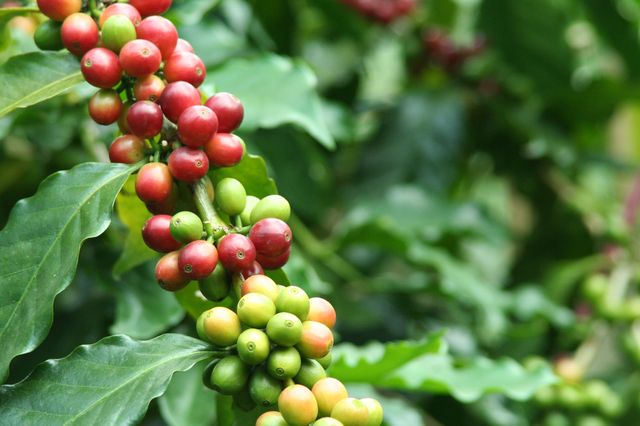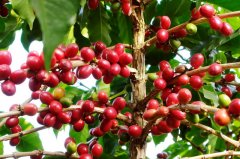Why should hand-made coffee be steamed? steamed coffee is the best.
For professional baristas, please follow the coffee workshop (Wechat official account cafe_style)

Steaming, which is often expressed as Bloom in English instructions, refers to the preparatory action of wetting a small amount of hot water evenly on the surface of coffee powder during hand flushing before formal water injection.
There are two purposes of steaming: first, to release the gas in the coffee particles, mainly carbon dioxide. Generally speaking, the closer it is to the baking time, the more bubbles usually occur during prepreg. On the other hand, the coffee beans with deeper roasting degree will release more gas in the steaming process than the coffee beans with lower roasting degree because of less water content.
Second, if the coffee particles after exhaust gas can be evenly absorbed and saturated, the subsequent extraction can be uniform. In short, during steaming, the air between the coffee powder particles expands and releases a large amount of carbon dioxide, while a short gap layer between the coffee powder particles will provide the space needed for hot water to pass through the powder layer during formal water injection.
If the initial step of hand flushing is less steaming, a large amount of hot water will follow a local and a small number of waterways through the powder layer, so that the dripping time will be longer, which may lead to excessive extraction, because the extraction time is longer and more substances are dissolved. the taste may be more sour and irritating, or full of miscellaneous taste. However, once you can pay attention to the action of steaming and then start formal water injection, the hot water can pass through the filter layer evenly composed of coffee powder, and then achieve the purpose of uniform extraction.
The following points will be conducive to the smooth achievement of steaming:
Before steaming with water, make sure the coffee powder is as horizontal as possible in the filter screen or filter paper.
When steaming, the force of injecting water is not too strong, gently.
The amount of water used in steaming should be 10% of the total water. For 240 milliliters of coffee, the amount of water needed for steaming is about 24 milliliters.
In the process of steaming, there is as little extract as possible; when there is too much extract in the kettle, the amount of water injected should be reduced, or attention should be paid to the degree of grinding.
The steaming time is about 30 to 60 seconds. When the expansion of the coffee powder surface is over and the surface is about to shrink, it means that the steaming is complete and the first water injection can be started. In an ideal steaming process, the coffee powder will slowly expand in the presence of hot water, as if the coffee powder keeps pushing the hot water to the top. At this time, the surface tension of the water and the pressure caused by the carbon dioxide released by the coffee powder add up to the gravitational acceleration of slightly larger water and the downward pulling force caused by capillarity. The best end time of steaming will be the sum of the surface tension of water and the pressure produced by carbon dioxide released by coffee powder when the expansion reaches the limit, which is slightly equal to the downward pulling force and stable water injection speed caused by the gravity acceleration of water and capillarity. at this time, the void layer in front of the coffee powder particles has not yet collapsed, so it is a good time to start the first water injection. Although the longer steaming time may get a thicker taste, it is also easy to affect the cooking results because of the larger surface area in contact with the air and the rapid decrease of water temperature.
Whether a cup of hand-brewed coffee has a pleasant flavor depends largely on whether a good filter layer is formed, except for the nature and freshness of the beans, while steaming will determine whether the hot water can pass evenly through the coffee powder. In Bloom is not only the prelude to coffee extraction, but also one of the key steps that can not be ignored in coffee extraction.
Important Notice :
前街咖啡 FrontStreet Coffee has moved to new addredd:
FrontStreet Coffee Address: 315,Donghua East Road,GuangZhou
Tel:020 38364473
- Prev

What is the meaning of caramel Caramel Macchiato in English? The difference from a caramel latte?
Professional coffee knowledge exchange more coffee bean information please pay attention to the coffee workshop (Wechat official account cafe_style) Starbucks coffee types and prices sweet taste slowly melt in the mouth, caramel and coffee after the perfect taste, like a lover's sweet greasy, let people sink. History: the Italian word Macchiato means branding
- Next

What is the best way to make coffee? how to control the change of taste and flavor?
Professional barista exchange please pay attention to the coffee workshop (Wechat official account cafe_style) first with the siphon pot brewing way, I chose the HARIO glass king TCA-3 siphon pot, said here, there is a small episode, yesterday at home just ran out of alcohol, early in the morning, ran all over the drugstores around the community, unexpectedly did not buy alcohol, dizzy. Later, I brought it to my friend on the way over.
Related
- Beginners will see the "Coffee pull flower" guide!
- What is the difference between ice blog purified milk and ordinary milk coffee?
- Why is the Philippines the largest producer of crops in Liberia?
- For coffee extraction, should the fine powder be retained?
- How does extracted espresso fill pressed powder? How much strength does it take to press the powder?
- How to make jasmine cold extract coffee? Is the jasmine + latte good?
- Will this little toy really make the coffee taste better? How does Lily Drip affect coffee extraction?
- Will the action of slapping the filter cup also affect coffee extraction?
- What's the difference between powder-to-water ratio and powder-to-liquid ratio?
- What is the Ethiopian local species? What does it have to do with Heirloom native species?

